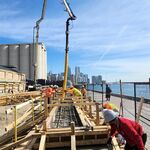EastYorkTTCFan
Senior Member
It'll have taken 8 years since the RFP started to get somewhere between 10-20 vehicles in service.
If we really go through with cancelling the contract, and starting a new RFP, say on January 1, 2016 ... then really we can only hope to have deliveries ramping up in 2023. Maybe 2022 if things really go well. And then deliveries through at least 2025.
If Bombardier can ultimately get their act together, and start delivering 4 cars a month, then it will be faster.
Costs would go up two ... what with nearly a decade of inflation ... and Bombardier bidding about $5 million per vehicles compared to about $7.5 million by the next closest bidder.
So why do something that would both delay things, and cost more money, unless there are significant quality issues. And all reports have been that the quality of the vehicles in service is quite good.
good points plus the CLRVs can't serve that much longer. The TTC has said they aren't worth rebuilding because they would need to be accessible and it was deem to dangerous to install a lift in them to make them accessible.





